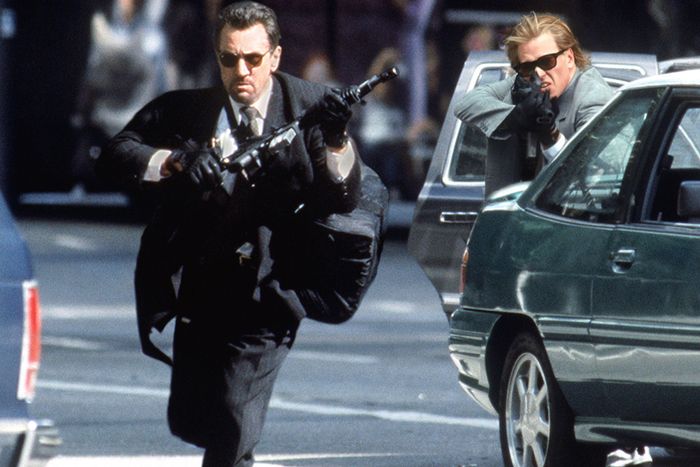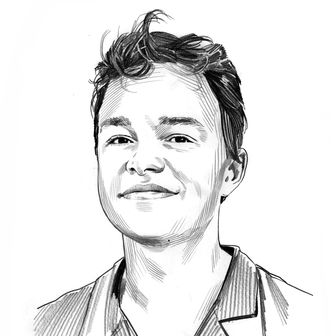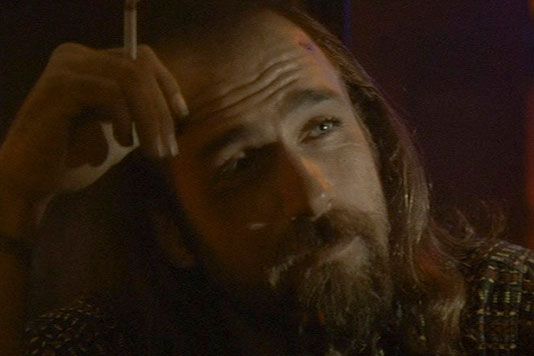
Michael Mann has spent decades of his life thinking about his 1995 crime epic, Heat. Specifically, the dynamic between its two protagonists, LAPD detective Vincent Hanna (Al Pacino) and professional thief Neil McCauley (Robert De Niro), had transfixed him as far back as the 1970s, when the Chicago detective Chuck Adamson planted the germ of a movie idea in the director’s head. Adamson told Mann about the time he got coffee with the real-life McCauley, and about how he and the thief developed a mutual respect for each other before Adamson’s team later killed McCauley in the street. Mann began writing and eventually used that basic premise for his 1989 TV movie, L.A. Takedown, before expanding on it six years later in Heat, a ludicrously ambitious, almost-three-hour movie that uses Hanna’s and McCauley’s entwined fates as the narrative backbone of a sprawling L.A. crime saga.
In the nearly three decades since its release, Heat has accrued an obsessive fan base and seemingly never strayed too far from Mann’s thoughts. In early 2020, the director undertook his version of a quarantine project by diving into work on his first novel, Heat 2, a 466-page tome that functions as both prequel and sequel to Heat, with the action cutting back and forth between a storyline set in 1988 and another that details the aftermath of the events in the film. Working alongside his co-author, the thriller writer Meg Gardiner, Mann clocked in long hours meticulously researching and writing a book that he hoped would read like “a really good screenplay in narrative form.” It’s a pulpy, expansive crime novel that feels of a piece with Mann’s filmography, from its hypercompetent, ambitious characters to the richly detailed underworlds they operate in. Oh, and it includes the phrase “sky-daddy shit.” (Warning: Some spoilers ahead.)
Vincent’s still obsessed with Neil years after the final showdown
Heat has no shortage of compelling supporting characters, but Mann’s ongoing obsession with the world he created still seems to revolve, first and foremost, around the idea that Hanna and McCauley are perfect foils for each other — just two damaged dudes who are committed to their jobs at the expense of everything else, and who understand that only one of them will survive their inevitable collision. (I’m sure some steamy fan-fiction exists out there somewhere.) Heat 2 deepens that entanglement, revealing that McCauley and Hanna unknowingly circled each other in Chicago in 1988, when the former pulled off at least one major heist and the latter worked as a detective before his move to L.A. In the post-Heat timeline, Hanna unearths some of the more redeeming elements of McCauley’s past and realizes that he can’t quite shake his obsession with McCauley and his crew even after their fatal showdown at the end of Heat.
The book reveals the origins of iconic moments from the film
As in all of his movies, Mann developed detailed backstories for each of Heat’s major characters while prepping the film. (“Even before I shot it, I knew what Neil was doing at age 11,” he told the Times.) While some of those details made it to the screen in Heat, Heat 2 gives Mann an opportunity to show off more of that legwork, providing a glimpse into McCauley’s and Hanna’s childhoods, the specifics of their deployments to Vietnam, and a bit more about how McCauley and Chris Shiherlis (played by Val Kilmer in the movie) became each other’s closest confidants. For those curious if McCauley reads anything aside from books about metals, Heat 2 explains that his personal philosophy was shaped by his time spent reading Camus in the prison library.
While these details are occasionally divulged in exposition dumps, more often they’re used to lay the groundwork for whatever set piece the book is hurtling toward next, such as when McCauley plans a heist near the Mexican border and articulates the assault plan in terms of Vietcong strategies he witnessed in combat. At times, Mann and Gardiner use the prequel portion of the book to directly explain the origins of iconic moments from the film (e.g., McCauley’s “30 seconds” mantra), but even those instances tend to feel motivated by the story rather than like cheap ploys to get readers to do the Leo pointing meme.
There’s a bit of Thief and Miami Vice in it, too
Over the course of his long career, Mann has amassed untold amounts of research into various niche topics, from serial-killer psychology to cybercrime to 18th-century hunting techniques. The world of Heat offers him a big enough canvas to contain nearly all of those obsessions, and part of the fun of Heat 2 lies in watching its authors pull ideas and tiny details from across Mann’s entire filmography. A Thief-esque vault heist early in the book foregrounds the kind of process-oriented details that Mann fans rejoice over, such as which specific drill bit cuts best through poured concrete and how to bypass the relocking mechanism on a safety-deposit box. In the post-Heat timeline, a subplot involving malware recalls Blackhat, while a segment in Ciudad del Este, a free-trade zone in Paraguay, allows Mann to utilize a setting that was originally intended for the ending of Miami Vice (2006).
It finds a villain to follow in Waingro’s footsteps
While the cat-and-mouse game between Hanna and McCauley anchors the film, it can be difficult to keep track of Heat’s many subplots. There’s the part about a teenage Natalie Portman’s suicide attempt (a baffling character arc, and one that the book acknowledges before wisely sidestepping) and the thread about a serial killer named Waingro (Kevin Gage) who goes around murdering sex workers in his free time. Part of Heat’s enduring magic is that it keeps the audience equally invested in both Hanna and McCauley, and it does so, in part, by pitting them both against Waingro, who embodies pure evil and declares himself the “Grim Reaper” at one point in the film.
Heat 2 finds a successor to Waingro in Otis Wardell, a thief who commits a series of home-invasion robberies and also likes to rape and murder his victims. Where McCauley is a professional criminal whose only endgame is the next score, Wardell is a chaos agent who gets off on violence. At various points, he becomes a problem for both Hanna and McCauley, and his arc helps tie together the book’s disparate timelines (arguably, a bit too neatly).
The sex scenes are … unforgettable
In his movies, Mann repeatedly subjects his self-serious, male protagonists to plots with operatic stakes. He pushes them to emotional extremes, so that when they fall in love — usually with a beautiful woman — they fall hard. (“For me, the sun rises and sets with her, man,” as Chris says of Charlene in Heat.) For all their displays of borderline campy masculinity, Mann’s movies are earnestly romantic, including Heat, which is punctuated by long interludes in which Neil and Eady (Amy Brenneman) spill their guts to each other while the synths of Terje Rypdal’s soundtrack blare in the background.
That same romantic impulse is present in Heat 2, but it doesn’t translate to the page as naturally as the action set pieces, which allow Mann to fall back on a visceral, pulpy style of prose (more than once, a bullet hits someone with the force of a “punch from a giant”). Instead, he sometimes resorts to clunky metaphors — one of them describes a woman who wants to have sex for the second time in one night as “a fighter pilot who has landed on an F-18 carrier deck. With the engines at max power, she’s ready to accelerate and take to the sky again.” Hopefully, the potential film adaptation drops the jet-fighter metaphors and lets an Audioslave song set the mood instead.
What’s next for Heat?
What is Heat without its movie stars? Much of the movie’s iconography is tied to its actors — even someone who doesn’t worship at the altar of Mann can probably recall that Heat is the first time De Niro and Pacino acted opposite each other, and just one viewing of the film will inevitably burn a few of Pacino’s line readings into your frontal cortex. Heat 2, though, paints complete enough portraits of its characters to allow you to imagine them separately from the stars who played them, making a film adaptation with new actors easier to imagine. Mann — who turned 79 earlier this year and is currently at work on his Enzo Ferrari biopic — has teased that a Heat 2 adaptation is already on the way and that it’ll be a “very large movie.” As for who will step in as Hanna and McCauley, Pacino’s got a few ideas.
Heat 2 hits bookstores August 9.




